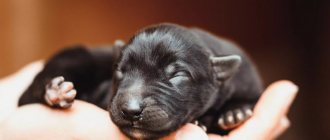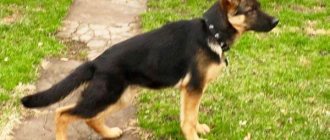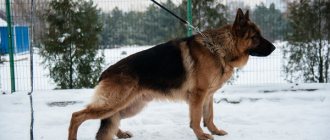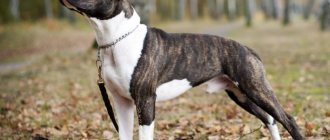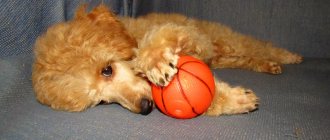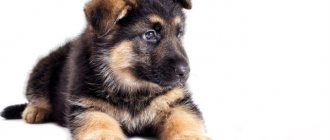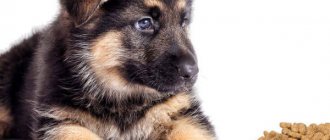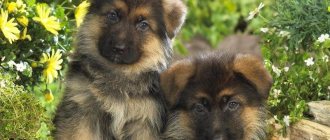The German Shepherd is popular among breeders due to the impressive list of positive qualities of representatives of this breed, including the ability to learn and train, a high level of intelligence, excellent working qualities, etc.
Buying a puppy is a responsible step. It is necessary to decide in advance about the purpose of its purchase and the desired gender, as well as prepare and find out what kind of care it needs.
The purpose of this article is to give future owners of German Shepherds and those who have only recently acquired a puppy of this breed, comprehensive information about the characteristics of these babies and the rules for their maintenance, so that many difficulties can be avoided.
What does it look like?
Newborn
Puppies in the first month of life all look the same. They have a pointed, elongated muzzle, with a large black nose.
Each puppy has short, shiny fur. Each of them weighs from 350-500 grams. The more puppies are born, the less the weight of each of them.
Description by month
When the baby turns one month old, characteristic differences appear:
- Size : from 18 – 21 cm.
- Body : The back is short and the chest is wide.
- Paws : against the background of the body they look very large, there is also no dewclaw.
- Weight : ranges from 3 to 4.5 kg.
- Eye color : dark brown, but in rare cases the color can remain blue for up to two months.
- Ears: soft and large, can hang up to 6 months.
- Teeth : There is a scissor bite on the front teeth.
- Coat : hard, thick undercoat has appeared.
When puppies reach 2 months of age, their paws and tail grow very much. Bones are formed in 28-30 days, but by the second month they are still very fragile.
The puppy becomes stronger in build by the 4th month, and the joint bumps are also very prominent.
If compared with a newborn puppy, by 6-7 months the size increases 7-8 times. The head becomes very large. At the age of 6 months, growth stops and muscle mass increases.
From 9 to 12 months, the young shepherd will rapidly gain weight. The muscles actively develop and the bone skeleton is finally strengthened. Growth stops, if it subsequently increases, it will be no more than 2-3 cm.
Photo
Below you can see photos of puppies aged 1, 2, 3 and 4 months, including black ones.
Choosing a puppy class
All dogs, regardless of breed, are classified into three classes - show, breed and pet, determined approximately until 5-9 months of age, since the puppy can move from one group to another. The show category includes animals for exhibition and breeding work, which breeders are reluctant to part with. The breed class includes healthy dogs that are less impressive than their show class counterparts, but are also allowed for breeding.
Dogs of the pet category are excluded from selection (they have disqualifying defects or significant exterior defects), which, however, does not affect their quality of life and ability to please the owner.
Important! For show-class German Shepherds the division is even deeper. The most selected “Germans” represent two areas – dogs for show and for service purposes. Both of them participate in exhibitions, but the criteria for their evaluation differ significantly.
Let us remind you that thanks to Captain Max von Stefanitz, the German Shepherd has become the best working dog in the world: it follows the scent, patrols the area, searches for explosives and drugs, herds herds, guides the blind, rescues from avalanches/rubles, protects the house and the owner.
But right now, according to dog handlers, show and working shepherd dogs are so different that they can confidently be classified into two breed groups (with serious differences in appearance and character). The difference is observed in the quality of the nervous system projected onto the dog's behavior. “Germans” of working breeding have a strong but agile psyche with pronounced instincts and an optimal balance of excitation/inhibition .
Working dogs, called "Leistungsucht", exhibit traits such as:
- activity;
- perseverance;
- courage;
- endurance;
- fast reaction;
- stress resistance;
- high adaptability.
The selection of "shousucht" (as opposed to "leistungsucht") focuses on obtaining brightly colored shepherd dogs with exemplary anatomy for spectacular presentation in the ring and photography. Here the nervous system and performance characteristics fade into the background, and the requirements for them become less stringent. Today, not a single show German Shepherd can compete with the Leistungsucht in tournaments where working qualities are tested.
Important! If you need a “German” to pose with in family photos, buy a show puppy. To protect the territory and household members, take a shepherd from the producers of working lines.
Return to content
Features of dog development at 1 year
This age is a very responsible one for a shepherd. The dog is going through the transition from being a teenager to being an adult dog. In appearance, this is a completely adult dog, but it will mature until it is 2 years old. The last parameter of maturation is the formation of the central nervous system.
Guard and defensive instincts are also formed. There may be attempts to prove their leadership among other dogs, which often ends in fights. Training will help get rid of unnecessary aggression.
Table of development and weight up to one year
| Age (month) | Height (cm) | Male weight (kg) | Female weight (kg) | Chest circumference (cm) |
| 1 | 19-22 | 3,3-4 | 3-3,4 | 28-32 |
| 2 | 32-40 | 8,5-9 | 7-8 | 45-50 |
| 3 | 40-47 | 14-15 | 11,5-12,5 | 55-59 |
| 4 | 48-57 | 19-20 | 16-16,5 | 60-65 |
| 5 | 50-58 | 22-23 | 20-22 | 65-70 |
| 6 | 52-60 | 24-26 | 22,5-23 | 69-72 |
| 7 | 53-62 | 28-28,4 | 23-24,8 | 70-72 |
| 8 | 53-62 | 28-30 | 25-25,3 | 73-74 |
| 9 | 53-62 | 30,5-32 | 27-27,5 | 74-75 |
| 10 | 54-63 | 32,2-32,9 | 28-29,5 | 75-77 |
| 11 | 54-63 | 33-33,5 | 28-29,5 | 75-77 |
| 12 | 55-64 | 33-35 | 30-32 | 75-77 |
When do teeth change?
The replacement of baby teeth begins in shepherd dogs between 12-14 weeks. Itching in the oral cavity is possible; to reduce it, you can give the puppy rubber toys or large bones. This will also help get rid of already loose baby teeth.
Attention! Some dogs experience fever and lethargy when they change teeth. If you notice that your pet is feeling unwell, then reduce walks and active games. Protect from stressful situations.
If you notice that a baby tooth is very loose, you can remove it yourself. When removing, pull the tooth upward to prevent damage. Firmly seated teeth should not be removed, as fragments may remain in the gums.
The change of canines occurs at the age of 4 months. At the age of 10 months, all of the dog’s teeth are molars.
Safety precautions
If a shepherd puppy grows up in a city apartment, a number of rules must be followed to protect it from injury. There are almost no differences here from other puppies or even small children:
- Wires should be hidden in special boxes or plinths.
- Strengthen or remove unstable furniture.
- Don't let him play with small, fragile toys: he will definitely break them and swallow the fragments.
- Anything that lies within his reach will be stolen and turned into a toy, so things must be put away in cabinets and drawers.
- To prevent the puppy from sharpening its teeth on all surrounding objects, it must have its own training equipment. They are sold in abundance in veterinary pharmacies - these are bones from ox veins, and scraps of rope, and cast heavy balls. You need to bring home 2-3 toys, and he will choose his favorite one.
- There should be a carpet or other similar covering on a slippery floor: the puppy’s weak paws are easily injured on a slippery floor.
- If there are children in the house, they need to be instructed how to properly handle the dog. The main thing is not to allow him to be picked up: even at three months he is quite heavy, up to 10 kg, and his paws are weak, they can easily be injured if he is accidentally dropped.
What time do your ears stand up?
Ears begin to stand up between 1.5 months and 5 months. Over time, the cartilage strengthens and the ears become larger. The change of teeth is directly related to the formation of the ears, so they can stand up at 2 months, and fall again by 3 months.
Observe the ears carefully from 5 to 6 months; if they are not erect by the age of six months, contact your veterinarian. After 7 months it is very difficult to place ears.
Why isn't this happening?
There are a number of reasons why German Shepherds' ears don't stand up:
- Not purebred shepherd. People are often deceived and sold non-purebred puppies. Such animals often have problems with the formation of ears. When purchasing, carefully check all documents for the dog.
- Insufficient amount of minerals. With poor nutrition and lack of essential substances, cartilage may not form properly.
- Ear diseases. Any inflammation can negatively affect the performance.
- Irregular fit or structure of the ears. Let's say the ears are very large and large or, on the contrary, thin. In this case, in order not to harm the animal, seek help from a veterinarian.
- Weak immunity and frequent illnesses. If your pet is often sick, he may not have enough nutrients to form cartilage.
How to install?
If your pet is more than 4 months old, and the ears are not set and are quite flaccid, you need to take action.
- Massage the ears. Massage stimulates blood circulation, which will have a positive effect when performing.
- Sound. Unusual and unexpected sounds will attract the puppy's attention, and he will turn around and raise his ears fully for a while. Thanks to such training, the muscle tissue of the auricle will be strengthened and over time it will completely move to a vertical position.
- Balanced diet. If the dog lacks nutrients, then cartilage will not develop. The menu must include: fish, dairy products.
- Introduce fertilizers with sufficient amounts of microelements.
- Glue the ears. You will need foam rollers without plastic inserts and a patch. Try to choose a curler based on the size of your ear, as too large or small will bring less benefit. Insert the foam rubber into the auricle without covering the ear canal, secure with adhesive tape. Do not use tape - it can injure the puppy's skin. The structure must be removed after seven days. If there are no changes, repeat the procedure.
Important! If, after taking measures, the ears still do not stand up by 6 months, contact your veterinarian.
History of the German Shepherd breed
German Shepherd
To trace the history of some breeds (for example, the Doberman and Airedale Terrier, which “come from” the 19th century, or the Old English Bulldog, bred in 1970), it is enough to refer to official documents and eyewitness accounts. With German Shepherds the situation is completely different. According to researchers, the beginning of the chain of their immediate ancestors should be sought in the depths of centuries.
Archaeological finds indicate that back in the 4th millennium BC, animals lived in the territory of modern Czech Republic, Poland and Germany, the skeleton of which has many features similar to shepherd dogs. These were the consequences of the evolution of wild individuals who chose to live near the sites of ancient tribes and became dependent on humans. It is assumed that even then a certain primitive selection was carried out, during which the largest and most obedient puppies were selected.
The now non-existent small Indian wolf increasingly moved away from its “free” relatives and gradually turned into the so-called Bronze Age dogs. Over time, people's needs have changed. Not only farmers, but also pastoralists were, to one degree or another, tied to a particular area. This means that the four-legged companions have new functions. In the Middle Ages, Hofwarts were bred throughout Europe. This German word is translated as “guardian of the yard,” but dogs were not only engaged in protecting real estate.
Domesticated cattle needed reliable protection from ruthless predators and hunters for other people's goods. Given the growing number of herds and flocks, it was simply impossible to cope with such a task with the help of shepherds. It was then that the yard dogs came to the rescue. Of course, not everyone was suitable for such work, but only the most savvy and resilient. They began to be selected and trained in a special way. And everything special is valuable, therefore, already in the 7th century, according to the laws of the ancient German Alemanni tribe, severe punishment awaited the culprit for the murder of a shepherd dog.
German Shepherd puppy
Of course, animals of the early Middle Ages, and even of much later eras, looked little like modern representatives of the breed. What was considered fundamentally important for the so-called primitive German shepherds was not the shape of the head and the position of the tail, but the corresponding intelligence, fairly large dimensions and a “psychological portrait”. The fact is that the lifestyle of shepherds implied long-term isolation; during the grazing season, the animals actually had contact exclusively with “their” person and had to not only obey unquestioningly, but also become good companions to him.
By the 18th century the situation had changed somewhat. Two regional types of German herding dogs took shape at once - the semi-long-haired Thuringian of a fawn-gray color with a curling tail and the long-haired Württemberg of a black or red color with semi-erect ears. They also differed in character: the former were called active animals, prone to loud and frequent barking, while the latter could boast of calmness and endurance. In the name of a common cause, breeders from the central and southwestern lands decided to join forces.
The result of the painstaking work of enthusiasts was presented to the general public only at the end of the 19th century. Baron von Knigge brought two of his pets, males Greif and Kiras, to the Hanover Dog Show in 1882. Later, interest in the new breed was fueled by the owners of the Hannau kennel, who showed the public an impressive pair - large and strongly built Pollux and Prima. It was thanks to them that almost two dozen champions and winners of exhibitions of subsequent decades were born.
In 1891, the creation of the first German Shepherd fanciers' society was announced. The Philax organization did not exist for long, but managed to approve the breed standard. The next significant event should be considered an exhibition in the small city of Karlsruhe on the German-French border. The event would have remained unnoticed by anyone if it had not been possible to see an outstanding representative of the old-format type. And not among the participants!
German Shepherd on duty
Hector von Lirkenhayn merely entertained visitors with a demonstration of herding skills. By a happy coincidence, retired military man Max von Stefanitz and his friend Arthur Meyer passed by, who devoted their free time to breeding German shepherds and immediately noticed the dog’s perfect external characteristics, in no way inferior to its working qualities. The owner, however, did not want to part with his pet so easily; negotiations took several weeks.
Having acquired the ideal “German”, von Stephanitz entered him as number one in the breeding book under a new name - Horand von Grafrath. At the same time, a large-scale search for females similar in type begins. The efforts were rewarded; in the litters received from Horand, a sufficient number of worthy successors of the breed were born. Most modern purebred lines are in one way or another connected with his son Hector von Schwaben, grandsons Pilot, Beowulf, Heinz von Starkenburg. The breeding of the black and yellow dogs recognizable today began with Hetel von Uckermark, son of Roland von Starkenburg. Another outstanding representative of the breed is Claudo von Boxberg, who won the international exhibition in 1925 and laid the foundation for new breeding lines.
Max von Stephanitz died in 1936. There is an opinion that this was indirectly facilitated by attacks from members of the National Socialist Party, who did not want the popularization of German shepherds outside Germany and even threatened the enthusiast with imprisonment in a concentration camp. During the Second World War, many nurseries were destroyed, many animals died, and no one cared about the purity of the blood of the remaining ones. But several valuable representatives of the breed were preserved, and in peacetime, von Stephanitz’s followers continued to work on the development of the breed. Exhibitions resumed in 1946, and five years later a new hero appeared at one of them - champion Rolf von Osnabrücker, the founder of modern “high breeding” lines.
Back in April 1899, the German Shepherd Owners' Union was created. The activities of von Stephanitz, Meyer and other leaders were aimed mainly at maintaining the purity of the blood, which would be confirmed by relevant documents, encouraging outstanding breeders and developing the working qualities of the breed. The organization still exists today, and in May 1968 an international association was founded, which today is known as the World Union of German Shepherd Associations and unites 89 national unions from 82 countries.
How to care for your pet?
- To keep your pet healthy, regular hygiene is necessary. Ears are cleaned once every two weeks.
To do this, apply a special product to a cotton pad and gently clean the ear. If the color of the discharge is yellow, it means everything is in order. But if the discharge is dark in color, contains pus, or has an unpleasant, pungent odor, contact your veterinarian. - You need to brush your shepherd twice a week. If the molting period has arrived - every day.
- Pay attention to your eyes. Dogs of this breed are not prone to eye diseases, but if you notice purulent discharge, redness or swelling, contact a specialist immediately.
- At the age of 2 months, begin to accustom your shepherd to cutting his nails. Lay the animal on its side or sit it down. Fix the chosen position and remove 2-3 mm of the nail with a special tool. Be careful not to touch the blood vessels. If you get it and start bleeding, treat the nail with peroxide.
- During the year, the dog is taken for vaccinations three times.
- At 1 month of age, begin introducing complementary foods. This can be either dry specialized food, soaked in water, or chopped, lean meat (rabbit, turkey). Kefir and cottage cheese are also allowed. Upon reaching 1.5 months, introduce porridge (rice and oatmeal). The meat can be cut into small pieces.
By the 3rd month it is necessary to introduce vegetables. First boiled, and after some time - raw.Number of meals:
- up to 2 months – 6 times;
from 2-3 months – 5 times;
- from 3-6 months – 3 times;
- from 6 months – 2 times.
Walking mode
For full development, the puppy should walk outside more. Of course, only after all vaccinations. When he is small, he can be taken out 5-6 times a day for 15-20 minutes. He must get used to going outside to relieve himself, so it is necessary to walk him immediately after sleep, after eating, and before bed. The older he gets, the longer the walks should be. The walk should be combined with games and training. After a year, the German Shepherd can be given for special training - capture, training in the “face” command. This is not necessary in order to turn him into a bodyguard; the shepherd will already protect his owner in a critical situation. This is necessary so that she gets used to discipline and unquestioning submission. After all, a large dog that cannot be controlled is a very dangerous phenomenon.
Walks should ultimately be at least 1 hour in the morning and 2 hours in the evening. In order for the dog to be socially active and not afraid of city noises, you should take it on short trips, guests, and give the puppy the opportunity to run around with peers.
Training a puppy begins from 1 month of his life: the earlier he starts to exercise, the more flexible his brain will become and the deeper his intellect. The first command for a puppy is his name. Then he can be taught commands: place, fu, sit, lie down, voice, next to him. These and several other similar commands make it easier to control the puppy and are called a general training course (GTC). He can take a special training course at a canine club or training school after a year.
Due to the ideal balance of strength and intelligence, the German Shepherd has become an indispensable assistant and partner for a person in almost all areas of his activity. She can be an excellent shepherd or guard. Millions of dogs of this breed serve in the military, police and other law enforcement agencies. They are sappers, trackers, and customs officers.
Who is better: a boy or a girl?
Before making a new friend, you need to decide on the gender. For a novice dog breeder, it is best to buy a girl. Females are more docile and easy to train. Males, on the contrary, show a character that will need to be pacified. But in turn, boys are more active, stately and somewhat larger in size.
The choice may be influenced by the purpose of purchasing this particular breed.
- If you are purchasing an animal for yourself and are encountering this breed for the first time, then it is better to take a girl. She becomes attached to her owner faster than a boy and is much easier to raise.
- For participation in exhibitions and possible breeding, a boy is best suited. If he has a good pedigree, then he will be of interest to breeders.
- For security or work, a boy is also better suited.
Character
- This is one of the most obedient dogs. She is distinguished by incredible devotion, flexible, strong. In extreme situations, it can protect the owner, so residents of remote areas, private households, and remote villages get a dog for protection.
- Brave, easy to train, intelligent, she has won the hearts of many dog lovers.
- The short-haired German Shepherd is always self-confident, aware of its actions, persistent in achieving goals, brave, and temperamental.
- Very obedient, willingly and diligently works during training, can be trained, and clearly follows the owner’s commands.
- It is in no way suitable for the role of a domestic dog, it needs discipline, you need to constantly work with the animal, monitor its behavior, and control it.
- She has a balanced character and harmonious appearance.
- In terms of intellectual development, he is in the top three.
- Service qualities are very developed.
- Intelligence, the correct construction of the body, the lines of the head, and the noble appearance make it what they say: here you can find everything you could want from a real four-legged creature.
How to choose?
- When choosing a puppy, first of all, you need to choose the right place. It is best to purchase German Shepherd puppies from specialized kennels.
- Pay attention not only to one dog, but to the entire litter. Are all animals active, does everyone have shiny fur? If at least one animal is in doubt, then you should not take a puppy in this place.
- Examine the puppy carefully. The paws should be very large in relation to the body, the animal should not be fat or thin.
- Pay attention to your bite. The bite should be scissor bite. If a dog is purchased for six months or older, then the ears must be set. The eyes should not be cloudy and the puppy should not look bug-eyed.
- The gait of a healthy dog is smooth. Dewclaws should be removed. There are no back irregularities or hunchbacks.
The puppy must have documents: pedigree (metrics) and veterinary passport.
The pedigree must indicate:
- Date of Birth;
- registration number;
- breed;
- information about parents.
Also information about the seller:
- address;
- Contact Information;
- requisites.
Puppies that have reached the age of 2 months must have a veterinary passport. It contains the results of examinations and vaccinations given.
Vaccination schedule
The table below shows the vaccination schedule for puppies by age, which veterinarians recommend following:
| Age | Graft | Revaccination | Using the example of the drug used |
| 8-10 weeks | from enteritis, from plague, from parainfluenza, from infectious hepatitis, from adeno- and parvovirosis, from leptospirosis | after 21-28 days |
|
| 12-13 weeks | from rabies | not being done |
|
When vaccinating, you should adhere to the following basic rules:
- 10-14 days before the procedure it is necessary to carry out deworming;
- You cannot vaccinate a puppy under 2 months old, a pregnant or lactating female;
- it is important to use the same drug for vaccination and revaccination;
- the puppy must be absolutely healthy.
All vaccinations must be repeated annually.
Slight lethargy and decreased activity of the puppy after vaccination is a normal reaction of the body.
Also, the first vaccination should not be given to the puppy before 8 weeks - not only is such vaccination considered “zero” among veterinarians (the puppy’s body simply will not develop immunity from diseases), but it can also significantly undermine the baby’s health.
How to determine purebredness?
It is very difficult to determine purebredness if the puppy is less than two months old.
- First of all, pay attention to your parents. The main characteristics of the breed are:
- topline;
- movements;
- head;
- ears and tail.
- A well-proportioned dog has a smooth topline from the withers to the tail without breaks or humps. If you see that the body is square in shape and the height at the withers is about 65 cm, this is a mixed breed.
- The dog should move easily and smoothly. If the movements are constrained, then you should not take puppies from such a dog.
- The skin on the head should be free of wrinkles and folds, and the nose should be black without spots. The jaws are powerful, but not narrowed. There should be no sagging lips. The lines of both the forehead and muzzle should be parallel.
- The ears should be turned forward. No breaks or unevenness. The tip of the ear is slightly curved back.
- The tail is long, without bends. The hooked tail indicates that it is a mestizo. The German Shepherd has a long, straight tail with a sharp tip.
Interesting Facts
Germans are rightfully considered the No. 1 breed in the world. The following interesting facts are associated with these brave animals:
- Working German Shepherds have saved many people. In doing so, they often sacrifice their lives.
- Representatives of the breed reach maximum speed almost instantly. They do not lose their balance during sharp turns and never stumble.
- During the war, dogs worked as sappers, orderlies, messengers, and carried cartridges.
- The clamping force of the jaws during a bite exceeds 100 kg/cm².
- A powerful animal with a muscular body and dry bones is capable of speeds of up to 50 km/h.
- Several monuments have been erected to the Germans. One of them is located in Tolyatti - here a dog waited for its owners on the side of the road for 7 years.
Weight and height standards
The size of the German Shepherd allows it to be classified as a large breed. This category includes animals whose weight exceeds 25 kg and height reaches 60 cm.
The breed standard establishes the following physical parameters:
- height at withers for boys 60–65 cm, for girls 55–60 cm;
- average weight 30–40 kg and 22–32 kg, respectively.
Important. The German Shepherd standard excludes animals higher or lower than the specified parameters by more than 1 cm.
The breed has pronounced sexual dimorphism. Males differ not only in weight and height at the withers, but also in physique - they are stronger and more massive than females. The difference is easy to see if you put a girl and a boy next to each other.
German Shepherds grow until they are 11–12 months old. But formation is completed only by 1.5–2 years.
The weight of an adult German Shepherd should not exceed the permissible limits. Excess pounds impair work performance and provoke the development of many diseases. Any deviation that affects performance characteristics is considered a serious defect.
On a note. It is believed that the largest German Shepherd lives in the Charming Bear kennel. This is a girl 65 cm tall and weighing more than 40 kg.
Color and varieties
German Shepherds come in three colors - black and yellow, gray, black. However, within each suit there are many subtypes. According to the standard, none of the colors has advantages over the other. There is only one requirement – good pigmentation.
The most common color of the German Shepherd is black and yellow. These are the dogs that appear in films and commercials. The back of the animal is covered with a V-shaped black mantle, covering the sides and top of the tail. The underparts are light - most often fawn, but can be brown or gray. There is always a black mask on the face.
Other colors of the German breed:
- plain black is one of the rarest colors. The shade of the coat is deep and rich. Particles of a different color are not acceptable;
- zonal gray - with a gray color there are dark spots on the back and a black mask on the face;
- zone-red - a red dog, like the zone-gray, has darkening on the back and a black mask on the face.
Read more about black German Shepherds in this article.
The White German Shepherd is outside the breed. She is characterized by an unstable character, timidity and timidity, and therefore is not suitable for performing official duties.
Depending on the structure of the coat, dogs are divided into two types:
- long-haired – the guard hairs are quite soft. Feathers form on the ears and limbs, and pants appear on the hips. The tail is bushy with a characteristic dewlap on the lower part;
- smooth-haired - thick, dense fur, with good undercoat. Slightly longer on neck, hips and tail. The hair does not puff up, but fits tightly to the body.
Read more about the long-haired German Shepherd here.
In Germany, only short-haired dogs are allowed to participate in exhibitions.
In 2010, German Longhairs were recognized as a separate breed. Previously, such animals were considered defective. Experts note that fluffy German Shepherds are overly excitable and nervous. Therefore, they are less often used as service dogs.
Important. It is prohibited to cross long-haired and short-haired animals.
There are dwarf German shepherds. This is an unrecognized variety that resulted from a genetic glitch. The animals are not allowed to be bred, but some people keep them as pets.
Black and other colors
There are three main colors:
- Black-and-white. Most dogs of this breed are of this color. A black spot covers the body from the elbows to the tail. The paws and belly are lighter.
- Zonal. It is also called wolf color. An interesting color is given by the unusual color of the bristles, which are light at the root and dark at the end. Very rare color.
- Black. The entire body is completely black. The presence of any other color is considered a defect. The rarest color.
Price range
The cost of a puppy depends on the region and place where it is purchased, color, age, compliance with the breed standard, health and class.
In Russia, the cost of a show-class dog starts from 63 thousand rubles, a breed-class puppy can be bought for 25-63 thousand rubles, and a pet-class pet will cost 3-5 thousand rubles.
